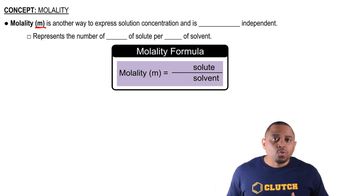Here are the essential concepts you must grasp in order to answer the question correctly.
Boiling Point Elevation
Boiling point elevation is a colligative property that describes how the boiling point of a solvent increases when a solute is dissolved in it. This phenomenon occurs because the presence of solute particles disrupts the formation of vapor above the liquid, requiring a higher temperature to reach the boiling point. The extent of boiling point elevation can be calculated using the formula ΔT_b = i * K_b * m, where 'i' is the van 't Hoff factor, 'K_b' is the ebullioscopic constant of the solvent, and 'm' is the molality of the solution.
Recommended video:
Van 't Hoff Factor (i)
The van 't Hoff factor (i) indicates the number of particles into which a solute dissociates in solution. For ionic compounds like Na2SO4, which dissociates into three ions (2 Na+ and 1 SO4^2-), the van 't Hoff factor is 3. This factor is crucial for calculating colligative properties, as it directly influences the extent of boiling point elevation and other related phenomena.
Recommended video:
Molality
Molality is a measure of concentration defined as the number of moles of solute per kilogram of solvent. It is expressed in units of mol/kg and is particularly useful in colligative property calculations because it remains unaffected by temperature changes. In the context of the question, knowing the molality of the Na2SO4 solution allows for the determination of how much the boiling point of water is elevated due to the dissolved solute.
Recommended video:
 Verified step by step guidance
Verified step by step guidance

